The James Bond (agent 007) character was created by author Ian Fleming for his novels, but he later took on a life of his own in the long-running film series. By my count, there have been twenty-five James Bond (agent 007) films to-date—the twenty-four “official” films by Eon Productions starring Sean Connery, George Lazenby, Roger Moore, Timothy Dalton, Pierce Brosnan, and Daniel Craig, as well as the unofficial 1983 film Never Say Never Again starring Sean Connery.
Below is my list of each of these films, complete with brief reviews, ordered from worst-to-best. This list will be updated as new James Bond films are released. Note that many of these brief reviews contain spoilers.
25. Moonraker (1979)
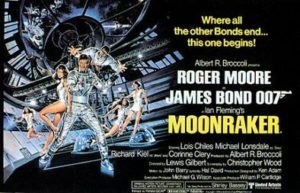 The saddest thing about Moonraker is that it had such potential. The first half of this Roger Moore film is quintessential 007. The opening sequence, with Bond thrown out of a plane without a parachute by the villain Jaws (Richard Kiel), is among the greatest openings in the series. The scene with Hugo Drax (Michael Lonsdale) at the hunting grounds is top-notch—both the sequence with Bond “missing” the birds but hitting the assassin, as well as the heart-wrenching killing of Corinne Dufour (Corinne Cléry) by hunting dogs. And the battle with Jaws atop a Rio de Janeiro aerial tram is also great 007 fun.
The saddest thing about Moonraker is that it had such potential. The first half of this Roger Moore film is quintessential 007. The opening sequence, with Bond thrown out of a plane without a parachute by the villain Jaws (Richard Kiel), is among the greatest openings in the series. The scene with Hugo Drax (Michael Lonsdale) at the hunting grounds is top-notch—both the sequence with Bond “missing” the birds but hitting the assassin, as well as the heart-wrenching killing of Corinne Dufour (Corinne Cléry) by hunting dogs. And the battle with Jaws atop a Rio de Janeiro aerial tram is also great 007 fun.
The plot is far too similar to its immediate predecessor, The Spy Who Loved Me, which also involves a rich madman trying to destroy the world so civilization can be rebuilt in his image. Worse, the film rapidly devolves into an idiotic parody of Star Wars, complete with a highly fictionalized version of the Space Shuttle, laser battles, and space marines. I’m not kidding. Other films on this list (especially the next two) are much more consistently horrible than Moonraker, but I rank Moonraker worst because of the contrast between its first half, which is almost great, and its second, which is nearly unwatchable. Moonraker is what happens when filmmakers with good instincts decide to just ignore them and do something trendy instead.
24. Diamonds Are Forever (1971)
 While Moonraker fails because of its inconsistency, Diamonds Are Forever fails because it is just bad through-and-through. Sean Connery had left the role two films earlier. George Lazenby took over as James Bond in On Her Majesty’s Secret Service, and did a reasonably good job (I rank that film above-average), but infamously chose not to reprise the role despite having a contract in-hand. So the producers of the series went back to Connery, waved a lot of money in his face, and got him back one more time (afterwards he said he would never play the role again . . . more on that when I get to Never Say Never Again).
While Moonraker fails because of its inconsistency, Diamonds Are Forever fails because it is just bad through-and-through. Sean Connery had left the role two films earlier. George Lazenby took over as James Bond in On Her Majesty’s Secret Service, and did a reasonably good job (I rank that film above-average), but infamously chose not to reprise the role despite having a contract in-hand. So the producers of the series went back to Connery, waved a lot of money in his face, and got him back one more time (afterwards he said he would never play the role again . . . more on that when I get to Never Say Never Again).
Diamonds Are Forever had a bad plot, a bad script, bad characters, and bad dialog. We had Jimmy Dean (of sausage fame) playing Willard Whyte, a bad simulacrum of Howard Hughes. We have the embarrassing assassins Mr. Wint and Mr. Kidd (Bruce Glover and Putter Smith), and the even more embarrassing bikini-clad bodyguards Bambi and Thumper (Lola Larson and Trina Parks). We have a moon-buggy chase in the desert. Tiffany Case (Jill St. John) tells a kid, “Go blow up your pants!” And it was pretty obvious that Connery didn’t have his heart in the role either, this being by-far his worst outing as the iconic character.
23. Die Another Day (2002)
 Pierce Brosnan’s era as James Bond began with GoldenEye, which is one of the better films in the series. It ended with Die Another Day, which is one of the worst. Like Moonraker, this film is better at the beginning and disintegrates as it goes. If you skip the opening credits that feature Madonna’s horrific theme song, there’s a lot to like in the first twenty minutes or so, especially if you tend toward the darker versions of 007. He’s a prisoner of war in a North Korean prison. He’s tortured. He’s finally released in a prisoner exchange, subject to a troubling debriefing, and his double-0 status is suspended.
Pierce Brosnan’s era as James Bond began with GoldenEye, which is one of the better films in the series. It ended with Die Another Day, which is one of the worst. Like Moonraker, this film is better at the beginning and disintegrates as it goes. If you skip the opening credits that feature Madonna’s horrific theme song, there’s a lot to like in the first twenty minutes or so, especially if you tend toward the darker versions of 007. He’s a prisoner of war in a North Korean prison. He’s tortured. He’s finally released in a prisoner exchange, subject to a troubling debriefing, and his double-0 status is suspended.
But the film quickly degrades into a mess where there is something about using gene therapy to change appearances, some nonsense about conflict diamonds, a cameo by Madonna, John Cleese trying very hard (and failing) to fill Desmond Llewelyn’s shoes as Q, a surprisingly poor showing by Halle Barry as the “Bond girl” Jinx, an invisible Aston Martin, an ice palace, Bond surfing on a melting glacier, and a cargo plane disintegrating in the air. And the computer effects are terrible too . . . far worse than other films of the day. This film is one of the great 007 mysteries . . . how did Pierce Brosnan and the people who made the previous three films go this far astray?
22. Never Say Never Again (1983) (Unofficial)
 It’s debatable whether Never Say Never Again is even really a James Bond film, since it was produced by a different company thanks to a complex legal backstory that dates back to the beginnings of the series. But it stars Sean Connery as the secret agent called James Bond, so it would be strange to leave it off the list. The film is actually an off-brand remake of Thunderball, which was the official 007 film from 1965 that also starred Sean Connery.
It’s debatable whether Never Say Never Again is even really a James Bond film, since it was produced by a different company thanks to a complex legal backstory that dates back to the beginnings of the series. But it stars Sean Connery as the secret agent called James Bond, so it would be strange to leave it off the list. The film is actually an off-brand remake of Thunderball, which was the official 007 film from 1965 that also starred Sean Connery.
Never Say Never Again came out in the same year as the official 007 film Octopussy with Roger Moore. The title is a tongue-in-cheek reference to Connery’s claim more than a decade earlier that he would never play 007 again.
As a result of its complicated background, Never Say Never Again suffers from being something we’ve seen before, and from lacking many of the standard 007 elements we’ve come to expect . . . things like Monty Norman’s James Bond Theme and Desmond Llewelyn as Q. We do have Sean Connery as James Bond, and playing the role better than he did in Diamonds Are Forever, but that’s about all we have here. It’s just . . . bland. It has a few enjoyable moments, but mostly it’s just a sad re-hash of a much better film.
21. A View to a Kill (1985)
 Roger Moore’s best 007 moments were all behind him by 1985. Four years earlier, after completing For Your Eyes Only, he had attempted to step down so that a younger man could take over the role. The producers talked him into Octopussy because they believed that an experienced 007 needed to lead the franchise against Sean Connery’s off-brand Never Say Never Again. That was understandable. But why did Moore return yet again in A View to a Kill?
Roger Moore’s best 007 moments were all behind him by 1985. Four years earlier, after completing For Your Eyes Only, he had attempted to step down so that a younger man could take over the role. The producers talked him into Octopussy because they believed that an experienced 007 needed to lead the franchise against Sean Connery’s off-brand Never Say Never Again. That was understandable. But why did Moore return yet again in A View to a Kill?
Moore, who was fifty-seven when he made this film, considers it to be his worst 007 film. He noted in an interview that he “was only about four hundred years too old for the part,” and that he was older than “Bond girl” Tanya Roberts’s mother.
Moore’s age, in and of itself, might have been forgivable . . . but he came across, like Connery in Diamonds Are Forever, as if his heart just wasn’t in it. Add to that Christopher Walken’s goofy performance as Zorin, along with a weak and hokey plot, and the whole film just feels . . . tired. You can’t help feeling like everybody involved, including James Bond himself, is ready to go home and take a nap. Grace Jones plays one of the more memorable “Bond girls,” May Day, but that is not enough to save this film from itself.
20. License to Kill (1989)
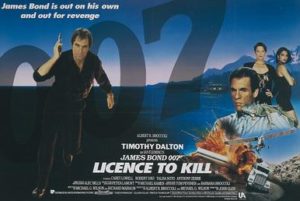 Timothy Dalton is generally regarded as a poor 007, and that is unfortunate. His interpretation of the character is darker and more troubled than Connery’s, Lazenby’s, or Moore’s, and was more true to the character that Ian Fleming created in the novels. Dalton’s two films prefigure the well-regarded dark turn that the series took twenty years later when Daniel Craig took over. Dalton was hamstrung by the relatively poor quality of the films in which he starred, and by the fact that the audience was not yet ready for a dark version of the character.
Timothy Dalton is generally regarded as a poor 007, and that is unfortunate. His interpretation of the character is darker and more troubled than Connery’s, Lazenby’s, or Moore’s, and was more true to the character that Ian Fleming created in the novels. Dalton’s two films prefigure the well-regarded dark turn that the series took twenty years later when Daniel Craig took over. Dalton was hamstrung by the relatively poor quality of the films in which he starred, and by the fact that the audience was not yet ready for a dark version of the character.
So, after audiences were surprised by Dalton’s take on 007 in The Living Daylights, the filmmakers decided to simultaneously plow ahead with that darker tone and throw in some more of the familiar campiness from the Moore era. This makes License to Kill one of the most bipolar and uneven films in the series. The maiming of Felix Leiter and the murder of Leiter’s wife are among the darkest 007 moments, but then we have nonsense like a bizarre religious cult headed by Wayne Newton. It’s nice to see Desmond Llewelyn’s Q out in the field though. That’s something.
19. The Man With the Golden Gun (1974)
 We’re getting into the part of the list where the films aren’t really bad, they’re just . . . mediocre. The Man With the Golden Gun is a quintessential example. It isn’t awful. You can watch it and enjoy it, even if Britt Eckland’s performance as Holly Goodnight is kind of like fingernails on a chalkboard. Oh, and the plot is hokey, and you can’t stop wondering why the redneck Sheriff J.W. Pepper (Clifton James) is back and is hanging out in Thailand, and there’s a slide-whistle sound effect during the spiral bridge jump, which is otherwise one of the most iconic car stunts in the history of film.
We’re getting into the part of the list where the films aren’t really bad, they’re just . . . mediocre. The Man With the Golden Gun is a quintessential example. It isn’t awful. You can watch it and enjoy it, even if Britt Eckland’s performance as Holly Goodnight is kind of like fingernails on a chalkboard. Oh, and the plot is hokey, and you can’t stop wondering why the redneck Sheriff J.W. Pepper (Clifton James) is back and is hanging out in Thailand, and there’s a slide-whistle sound effect during the spiral bridge jump, which is otherwise one of the most iconic car stunts in the history of film.
Roger Moore is in his prime as James Bond. Christopher Lee turns in a compelling performance as the main villain, Francisco Scaramanga. Maud Adams is really excellent as Scaramanga’s mistress, Andrea Anders. And some of the campy scenes—those with Scaramanga’s Sumo wrestlers, those with Hip’s nieces, and the flying AMC Matador—are even kind of fun. But this film is just too campy. It goes as far as it should, and then two steps further. The over-the-top silliness peppered throughout undermines an otherwise solid film. Moore does as much as he can with the material, but it’s just not enough.
18. Quantum of Solace (2008)
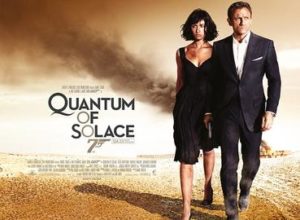
I am tempted to review Quantum of Solace by just saying, “It is unremarkable,” and moving on.
When Daniel Craig was cast as James Bond in Casino Royale, and when the film ended up being pretty great, it reinvigorated a franchise that had been left reeling after the complete misfire of Die Another Day. And Craig does hold up his end of the bargain here, as does the rest of the cast. Olga Kurylenko is one of the more compelling “Bond girls,” and Mathieu Amalric does a commendable job as the primary villain, Dominic Greene. Giancarlo Giannini and Jeffrey Wright competently reprise their roles as Mathis and Leiter.
But top-notch casting can’t save a movie that just seems to be simultaneously frenetic and listless. Part of the problem is the overly-jumpy directing and editing, which famously gave some theater-goers motion sickness. But even watching at home on the ‘small screen,’ there just isn’t much to like about Quantum. There is nothing especially memorable about the film. It’s hard to explain . . . all the components of a great 007 film are here, but they just don’t come together the way they should.
17. Live and Let Die (1973)
 Roger Moore had an impossible task when he was cast as James Bond in 1973’s Live and Let Die. The role that Sean Connery had defined in 1962 in Dr. No, the first James Bond film, was irrevocably tied to Connery’s interpretation. George Lazenby had mostly risen to the challenge in On Her Majesty’s Secret Service, but then Connery returned in Diamonds Are Forever . . . and the man who created the role had actually failed to do it well. Then it was Moore’s turn. The conduit for his debut as 007 was a mediocre film about drug smugglers. It lacked the punch of most of the earlier entries in the series.
Roger Moore had an impossible task when he was cast as James Bond in 1973’s Live and Let Die. The role that Sean Connery had defined in 1962 in Dr. No, the first James Bond film, was irrevocably tied to Connery’s interpretation. George Lazenby had mostly risen to the challenge in On Her Majesty’s Secret Service, but then Connery returned in Diamonds Are Forever . . . and the man who created the role had actually failed to do it well. Then it was Moore’s turn. The conduit for his debut as 007 was a mediocre film about drug smugglers. It lacked the punch of most of the earlier entries in the series.
Live and Let Die is largely set in the United States, and the film controversially adopts some elements of the “Blaxpoitation” films of the era. This was bad enough at the time, and has only grown more objectionable in the decades since. Jane Seymour does a reasonably good job as the main “Bond girl,” but the film overall is just . . . uninspired. Most notably, the “comic relief” of Sheriff J.W. Pepper (Clifton James) generates more groans than laughs. What else about Live and Let Die is memorable? The opening sequence, a New Orleans funeral procession, is interesting. Though campy, Bond hop-scotching over a series of alligators is pretty great. The boat chase, if you edit out J.W. Pepper, would be okay. It has a truly great theme song. Anything else?
16. Tomorrow Never Dies (1997)
 Tomorrow Never Dies is another one of those James Bond films that had a lot going for it, but failed to rise to the challenge. Pierce Brosnan had definitively seized the role in 1995’s GoldenEye, and that was an excellent film and a hard act to follow. He played the role well in Tomorrow Never Dies, but he just didn’t have as good a story to work with.
Tomorrow Never Dies is another one of those James Bond films that had a lot going for it, but failed to rise to the challenge. Pierce Brosnan had definitively seized the role in 1995’s GoldenEye, and that was an excellent film and a hard act to follow. He played the role well in Tomorrow Never Dies, but he just didn’t have as good a story to work with.
Jonathan Pryce does a decent but unremarkable job as Elliot Carver, the megalomaniac media mogul. Teri Hatcher also turns in a quality performance as Paris Carver, wife of Elliot and a former lover of Bond’s. The stand-out performance of the film is Michelle Yeoh as Wai Lin, the bad-ass Chinese agent who could have (and should have) been given a spinoff film series of her own.
But the helicopter scenes violate the basic laws of physics, the talk about GPS encoders is so half-baked that it hurts, and . . . a stealth boat? Really? The rest of the film just comes across as an effort to ‘go through the motions.’ There is little originality here. Watching Tomorrow Never Dies is an exercise in noting where it rips-off the many Bond films that came before. It does have a bit of heart though, most notably the interaction between Bond and Q as the BMW is introduced. It’s nice to see 007 in his Royal Navy uniform. And the scene at the terrorist arms bazaar is one of the better opening sequences in the series. Otherwise, it’s a middling entry in the Bond canon.
15. Octopussy (1983)
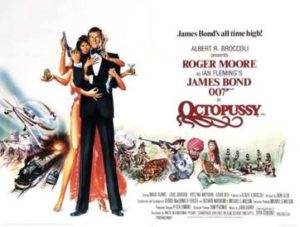 After 1981’s For Your Eyes Only, Roger Moore had expressed a desire to step down as James Bond. He believed he was growing too old to play the character credibly . . . which was probably true. But when Sean Connery, also well past his 007 prime, announced that he would star in the off-brand James Bond film Never Say Never Again, the producers of the official series asked Moore to stay on and go head-to-head against Connery.
After 1981’s For Your Eyes Only, Roger Moore had expressed a desire to step down as James Bond. He believed he was growing too old to play the character credibly . . . which was probably true. But when Sean Connery, also well past his 007 prime, announced that he would star in the off-brand James Bond film Never Say Never Again, the producers of the official series asked Moore to stay on and go head-to-head against Connery.
Needless to say, 1983 was a very weird year for James Bond . . . two 007 films with two iconic (but aged) 007 actors. Octopussy with Roger Moore was a better film than Never Say Never Again with Sean Connery, but Moore’s instincts were definitely right. He was too old to play the character. The filmmakers’ efforts to counteract Moore’s age with childish antics were not helpful.
The campiness that had entrenched itself into the series by the late 1970s was wearing dangerously thin by 1983, and paired poorly with the film’s otherwise more serious tone. The plot is trite and goofy. And yet, we have some great moments scattered throughout. The film has some heart. The high points are the compelling performances by Louis Jourdan and Maud Adams as Kamal Khan and Octopussy respectively.
14. The Spy Who Loved Me (1977)
 In 1967’s You Only Live Twice, arch-villain Blofeld, head of SPECTRE, uses a specialized rocket to capture American and Soviet space capsules in an effort to prompt a war between the two superpowers so that he and his allies can remake the world in their image. In 1977’s The Spy Who Loved Me, megalomaniac Karl Stromberg uses a specialized tanker ship to capture British and Soviet submarines in an effort to prompt a civilization-ending nuclear war so that he can create a new undersea paradise.
In 1967’s You Only Live Twice, arch-villain Blofeld, head of SPECTRE, uses a specialized rocket to capture American and Soviet space capsules in an effort to prompt a war between the two superpowers so that he and his allies can remake the world in their image. In 1977’s The Spy Who Loved Me, megalomaniac Karl Stromberg uses a specialized tanker ship to capture British and Soviet submarines in an effort to prompt a civilization-ending nuclear war so that he can create a new undersea paradise.
This movie is 007 deja vu. We’ve seen something very much like this movie before. In fact, in early scripts, Stromberg was Blofeld . . . but the legal battles over that character and SPECTRE led the filmmakers to create a new villain instead.
There’s a lot to like in The Spy Who Loved Me. We have the ‘foes-become-friends’ dynamic between Roger Moore’s Bond and Barbara Bach’s Soviet Agent Triple-X, the introduction of Richard Kiel as Jaws, and the iconic Lotus Espirit submarine. We have Bond disabling Jaws with an electromagnet. We have some of the best quips and one-liners in the series, but also one of the coldest kills of the Moore era (when he knocks Sandor’s hand away from his tie, causing Sandor to fall to his death). But You Only Live Twice is derailed by being about five percent too campy, and, worse, by its shamelessly rehashed plot.
13. The World Is Not Enough (1999)
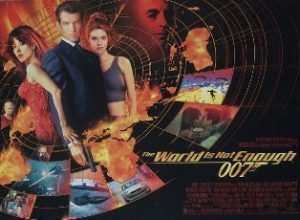 Pierce Brosnan’s 007 just never managed to top his first outing in GoldenEye, but The World Is Not Enough is where he came closest. It has some major flaws. The bizarre casting of Denise Richards as nuclear physicist Christmas Jones is hard to forgive, as is the under-utilization of Robert Carlyle as Renard, the terrorist with a bullet in his head that renders him impervious to pain. And something just doesn’t feel right about James Bond driving a BMW Z8 roadster. I was willing to forgive the multi-film deal with BMW as long as they had him in BMWs that made sense for the character, but the Z8? Really?
Pierce Brosnan’s 007 just never managed to top his first outing in GoldenEye, but The World Is Not Enough is where he came closest. It has some major flaws. The bizarre casting of Denise Richards as nuclear physicist Christmas Jones is hard to forgive, as is the under-utilization of Robert Carlyle as Renard, the terrorist with a bullet in his head that renders him impervious to pain. And something just doesn’t feel right about James Bond driving a BMW Z8 roadster. I was willing to forgive the multi-film deal with BMW as long as they had him in BMWs that made sense for the character, but the Z8? Really?
But Sophie Marceau expertly plays oil heiress Elektra King, who is one of the greatest (and saddest) “Bond girls” in the series. Her performance alone bumps this film up about two slots in the list.
Otherwise, it’s good, action-packed 007 fun. It has a good mix of absurdity (like the villains trying to set off a nuclear explosion in the middle of Istanbul just to damage some oil pipelines) and timeliness (it is set in the late 1990s and is all about oil, energy, business, and power). The World Is Not Enough earns a position near the middle of the 007 canon. It’s good, but it falls short of greatness.
12. Spectre (2015)
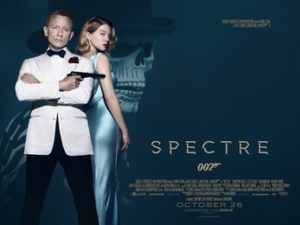 Spectre continues in the more gritty style that had been ushered in (along with Daniel Craig) in 2006’s Casino Royale, but the plot here is depressingly thin. It attempts to play on fears of the abuse of government surveillance, but that whole aspect of the plot feels . . . contrived. It tries to give us a big world-domination plan like SPECTRE’s efforts of yore, but doesn’t rise to the challenge.
Spectre continues in the more gritty style that had been ushered in (along with Daniel Craig) in 2006’s Casino Royale, but the plot here is depressingly thin. It attempts to play on fears of the abuse of government surveillance, but that whole aspect of the plot feels . . . contrived. It tries to give us a big world-domination plan like SPECTRE’s efforts of yore, but doesn’t rise to the challenge.
The sort-of ret-con of Blofeld as somebody from Bond’s childhood feels like a cheap attempt to capitalize on the deepening backstory of James Bond from the previous film, Skyfall. Even more transparent is the effort to tie together the various underworld organizations from each of the three previous Craig-era 007 films.
It’s still a good movie. Christoph Waltz plays Blofeld well, even though he had many odd shoes to fill. Monica Bellucci is a stand-out as Lucia Sciarra, a dark, sad character in the vein of Andrea Anders (Maud Adams) from The Man With the Golden Gun or Elektra King (Sophie Marceau) from The World is Not Enough. The scene where Bond meets with Mr. White (Jesper Christensen), who is dying of thallium poisoning, has real heart in a way. Léa Seydoux is excellent as Mr. White’s daughter, Dr. Madeleine Swann, and the development of her relationship with Bond is handled well by the filmmakers. Overall, Spectre is fun . . . but average.
11. On Her Majesty’s Secret Service (1969)
 On Her Majesty’s Secret Service was the first and only time that George Lazenby played 007, taking over the role from Sean Connery, and afterwards relinquishing it back to to him again. Thus, he is sometimes the “forgotten Bond.” Some James Bond aficionados consider this the best of the 007 films, an accolade that goes too far but is, in a way, understandable.
On Her Majesty’s Secret Service was the first and only time that George Lazenby played 007, taking over the role from Sean Connery, and afterwards relinquishing it back to to him again. Thus, he is sometimes the “forgotten Bond.” Some James Bond aficionados consider this the best of the 007 films, an accolade that goes too far but is, in a way, understandable.
This was the first time that the filmmakers attempted to inject some real emotional drama into the series. Bond falls in love with Contessa Teresa di Vicenzo, deftly played by Diana Rigg . . . then, in the heartbreaking ending, she is killed. That ending was polarizing, but I think it was very well done.
There are other things to like about the film. The action scenes stand on-par with others from the era. Lazenby, though just beginning to settle into the role, does pretty well. Blofeld’s plan to brainwash women at a remote allergy clinic so they can disseminate biological agents around the world is absurd in the best kind of way. But the film is just too slow and about five percent too cheesy. Worst of all, the filmmakers commit the cardinal sin of breaking the fourth wall: After Theresa runs away from Bond in the opening sequence, he looks directly at the camera and says to the audience, “This never happened to the other fellow.”
10. The Living Daylights (1987)
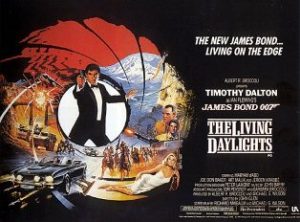 After two too-many Roger Moore movies, Timothy Dalton was cast as 007 and the series underwent one of its many half-reboots. And like they did with George Lazenby in 1969’s On Her Majesty’s Secret Service, and later with Pierce Brosnan and Daniel Craig in 1995’s GoldenEye and 2006’s Casino Royale respectively, the filmmakers took the new 007 in a darker, grittier direction.
After two too-many Roger Moore movies, Timothy Dalton was cast as 007 and the series underwent one of its many half-reboots. And like they did with George Lazenby in 1969’s On Her Majesty’s Secret Service, and later with Pierce Brosnan and Daniel Craig in 1995’s GoldenEye and 2006’s Casino Royale respectively, the filmmakers took the new 007 in a darker, grittier direction.
The Living Daylights was not well regarded in its time because fans, dulled by the campy aire of the Moore era, weren’t ready for a brooding, serious, and unhappy 007. But here we get a preview of what the series would later become under Brosnan’s and Craig’s tenures. The film is full of action, yes, but unlike some others in the series it is also full of espionage and double-crosses and cleverness. Remember, 007 isn’t just an action hero, he’s also a spy. We also get an alliance with Kamran Shah (Art Malik) and the Mujahadin in Afghanistan, opium-dealing allies of convenience, demonstrating that the series is redeveloping some nuance.
There’s still some campiness, but it is on the wane. Yes, the film drags in the middle, and Maryam d’Abo as Kara Milovy, is low on the list of “Bond girls” (though we get some good scenes with her cello case). But this film is better than you might remember.
9. For Your Eyes Only (1981)
 Periodically in the James Bond canon, the filmmakers realize that they have gotten too silly and correct into a darker, more serious style that hearkens back to the Ian Fleming novels. These ‘reboots’ usually coincide with a change in actors, but For Your Eyes Only is a unique counterexample. Moonraker starred Roger Moore and was, in my humble opinion, the worst film in the series . . . and then just two years later, Moore returned in For Your Eyes Only, which I rank as his best outing as 007.
Periodically in the James Bond canon, the filmmakers realize that they have gotten too silly and correct into a darker, more serious style that hearkens back to the Ian Fleming novels. These ‘reboots’ usually coincide with a change in actors, but For Your Eyes Only is a unique counterexample. Moonraker starred Roger Moore and was, in my humble opinion, the worst film in the series . . . and then just two years later, Moore returned in For Your Eyes Only, which I rank as his best outing as 007.
From the get-go, it’s clear that Bond is taking a new direction. The opening sequence has James Bond killing an unnamed character who is clearly intended to represent the perennial arch-villain of old, Ernst Stavro Blofeld.
The film has its flaws. I could do without the weird subplot involving figure skater Bibi Dahl, which seemed like little more than a convoluted excuse to cast Lynn-Holly Johnson, who is a talented real-life figure skater. But the revenge tale centered on Carole Bouquet’s Melina Havelock is top-notch, the ATAC is a classic 007 ‘MacGuffin,’ and the film gives us a masterful mix of serious drama and lighthearted 007 moments. It is a shame that the filmmakers talked Moore into returning as Bond in an additional two films. If he had quit after For Your Eyes Only, as he had originally intended, he would have gone out on a very high note.
8. Thunderball (1965)
 Thunderball is perhaps most remembered for the bizarre legal wrangling around it. The story was originally written by Kevin McClory and was intended to become the first 007 film. Ian Fleming wrote a 007 novel based on McClory’s story, and was sued by McClory for plagiarism. McClory won. As a result, he became the producer when Thunderball became the fourth official 007 film . . . but because he retained the rights to the story, he later licensed it to another studio, and thus was born the infamous off-brand 007 film, 1983’s Never Say Never Again.
Thunderball is perhaps most remembered for the bizarre legal wrangling around it. The story was originally written by Kevin McClory and was intended to become the first 007 film. Ian Fleming wrote a 007 novel based on McClory’s story, and was sued by McClory for plagiarism. McClory won. As a result, he became the producer when Thunderball became the fourth official 007 film . . . but because he retained the rights to the story, he later licensed it to another studio, and thus was born the infamous off-brand 007 film, 1983’s Never Say Never Again.
It’s a shame though, because Thunderball is in its own right a very good James Bond film. It far outperforms its off-brand remake.
The plot itself, where SPECTRE captures a pair of nuclear missiles from a ditched bomber, seems trite today but was quite inventive in its day. Laudine Auger plays “Bond girl” Domino well. Overall, this is just good, old-fashioned 007 fun. Sean Connery is in his prime as the kind of suave, womanizing secret agent who would be immediately referred to the H.R. department today. And the whole series is in its prime too . . . far enough along to be confident in itself, but also young enough to be original and interesting.
7. From Russia With Love (1963)
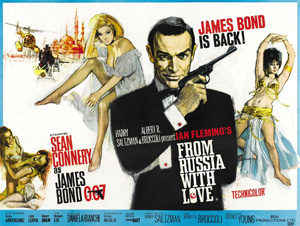 James Bond first appeared on the big screen in 1962’s Dr. No. Sean Connery returned as the now-iconic secret agent only one short year later in From Russia With Love. And while Dr. No benefits from a somewhat artificially high ranking just because it came first, this film is where the 007 series really came into its own. The series is just beginning to settle into the comforting tropes and standards that would guide it for decades to come.
James Bond first appeared on the big screen in 1962’s Dr. No. Sean Connery returned as the now-iconic secret agent only one short year later in From Russia With Love. And while Dr. No benefits from a somewhat artificially high ranking just because it came first, this film is where the 007 series really came into its own. The series is just beginning to settle into the comforting tropes and standards that would guide it for decades to come.
This film is where we meet arch-villain Blofeld, as well as the first Russian “Bond girl” Tatiana Romanova (Daniela Bianchi). Desmond Llewelyn makes his first appearance as Major Boothroyd, the gadget-man more commonly known as Q, who gives Bond an iconic briefcase containing a throwing knife, tear gas, a sniper rifle, and gold sovereigns. The “MacGuffin” is the Lektor decoder. Bond takes out a helicopter with a single, well-placed shot from a sniper rifle. There’s an exciting boat chase culminating in an epic explosion. Connery plays the character as confidently as he ever did.
The production of the film famously went far over budget and had numerous debacles, but the excesses of the production process are part of what gives this film such charm. Yes, it’s over-the-top and sort of absurd . . . but in the best kind of way.
6. GoldenEye (1995)
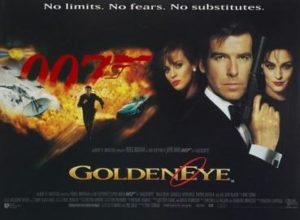
After 1989’s License to Kill, the filmmakers put the series to rest for six years. It needed it. Timothy Dalton’s era was marked by a shift in a darker direction that was ahead of its time, but the filmmakers could not fully commit to it because the fans would not accept it so soon after the campiness of the Roger Moore era. When the series returned in 1995, it returned with Pierce Brosnan as Bond and a new attitude. And boy was it good.
While Brosnan’s tenure as 007 ended on the sour note of Die Another Day, we should remember that it was so much better at its start. GoldenEye is fresh, smart, fun, and exciting. Judi Dench excels as the first female M. Samantha Bond steps right into the role of Miss Moneypenny. Sean Bean competently plays double-crossing Alec Trevelyan. Izabella Scorupco is good, but somewhat unremarkable, as the first “Bond girl” of this new era. And Brosnan’s performance here is essentially perfect.
The plot is a bit strained at points, and at its start the film is a bit too eager to assert Brosnan’s “Bond-ness,” but it all comes together and works out in the end. And how couldn’t you love 007 recklessly driving around in a stolen Russian tank? I should also mention that GoldenEye was the first 007 film that I ever saw in theaters.
5. You Only Live Twice (1967)
 By 1967, the iconic 007 standards were well-established. They all appear in their highest forms here in the fifth film of the series. We have Donald Pleasence’s parody-worthy version of Blofeld, an epic enemy base hidden in a volcano, the exotic locale and culture of Japan (portrayed in a way that, to modern eyes, might seem racist), and the absurd SPECTRE plot to initiate a war between superpowers. Even better we have assassination by piranha, a rocket “exploder button,” ninjas, space capsules, and a gyrocopter with antiaircraft missiles.
By 1967, the iconic 007 standards were well-established. They all appear in their highest forms here in the fifth film of the series. We have Donald Pleasence’s parody-worthy version of Blofeld, an epic enemy base hidden in a volcano, the exotic locale and culture of Japan (portrayed in a way that, to modern eyes, might seem racist), and the absurd SPECTRE plot to initiate a war between superpowers. Even better we have assassination by piranha, a rocket “exploder button,” ninjas, space capsules, and a gyrocopter with antiaircraft missiles.
And how could we possibly forget James Bond’s laughably poor disguise as a Japanese man; the filmmakers just gave Sean Connery a weird haircut and bushy eyebrows. It’s all so dumb . . . and yet, somehow, it is also great. You Only Live Twice manages to be simultaneously stupid and wonderful. It is both a Bond film and a masterful parody of one.
This is a film that is lovably dated and yet inexplicably timeless. From the opening scene—where 007 fakes his own death—all the way through the epic battle and the humorous ending—where a submarine surfaces underneath Bond and Kissy Suzuki (Mie Hama) in a raft—this is one of the most memorable masterpieces of the series. Its only real flaw is that it shifted the series hard into a more campy and silly direction, which was fine just this once but got really annoying really fast.
4. Skyfall (2012)
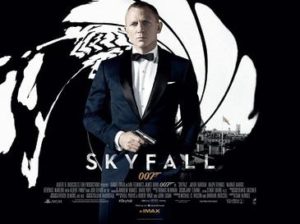 Daniel Craig took the helm as James Bond in 2006’s Casino Royale—one of the best in the series—which was followed by 2008’s unremarkable Quantum of Solace. But those films, taken together, serve as an extended reboot that took Bond back to his roots and set him on a new footing for the modern era. In 2012’s Skyfall, the reboot reached its completion. The character had been reestablished, Craig had taken full control of it, and now it was time to do a good, old-fashioned 007 film.
Daniel Craig took the helm as James Bond in 2006’s Casino Royale—one of the best in the series—which was followed by 2008’s unremarkable Quantum of Solace. But those films, taken together, serve as an extended reboot that took Bond back to his roots and set him on a new footing for the modern era. In 2012’s Skyfall, the reboot reached its completion. The character had been reestablished, Craig had taken full control of it, and now it was time to do a good, old-fashioned 007 film.
The theme song by Adele hearkens back to the early greats. Villain Raoul Silva is diabolically and memorably played by Javier Bardem. MI6 is forced to contend with itself being the target of terrorism, and Judi Dench’s portrayal of M is as good as ever. “Bond girl” Sévérine is played darkly by Bérénice Marlohe. Ben Whishaw reintroduces the character of Q, and is a worthy successor to (but not a replacement for) Desmond Llewelyn.
Skyfall has a real emotional depth, and yet does not sacrifice any of the action and excitement that has always driven the series. And it’s great to see the classic Aston Martin DB5, the greatest of all the 007 cars, back in the spotlight.
3. Dr. No (1962)
 Here is where it all began. Dr. No was the first James Bond film, and one of the best in the series. It set the tone for every film that would follow. It had the opening ‘gun barrel’ and an abstract title sequence by Maurice Binder, the visual style of production designer Ken Adam, the iconic James Bond Theme by Monty Norman orchestrated by John Barry, the introduction of the “Bond . . . James Bond” catch phrase, the on-location filming in beautiful and exotic Jamaica, and Ursula Andress as the inaugural “Bond girl,” Honey Ryder.
Here is where it all began. Dr. No was the first James Bond film, and one of the best in the series. It set the tone for every film that would follow. It had the opening ‘gun barrel’ and an abstract title sequence by Maurice Binder, the visual style of production designer Ken Adam, the iconic James Bond Theme by Monty Norman orchestrated by John Barry, the introduction of the “Bond . . . James Bond” catch phrase, the on-location filming in beautiful and exotic Jamaica, and Ursula Andress as the inaugural “Bond girl,” Honey Ryder.
Its position as tone-setter bumps it up the list a bit higher than it might have been otherwise. Objectively, the film moves too slowly, the plot is too thin, and—sorry—I just don’t think Andress is all that great here. But Sean Connery seized the role of James Bond with both hands and made it his own, cementing both himself and 007 into movie history.
The film has some good, semi-realistic espionage in it, which is well sandwiched between the typical over-the-top evil plans, villains, and lairs of SPECTRE. Joseph Wiseman’s metal-handed Dr. No is not as terrifying as he should be, but helps set the tone for the many villains—including Blofeld—who would follow. The effort by SPECTRE to radio-jam American space launches in Florida is classic Bond wackiness, as is the final battle and destruction of Dr. No’s island lair. All-in-all, Dr. No was a really great start.
2. Casino Royale (2006)
 The novel Casino Royale by Ian Fleming was published in 1953, and was the first book in the James Bond series. Fleming had sold the film rights to a producer who never made it, and it took until 1999 for Eon Productions and MGM/UA—the producers of the official 007 series—to reunify those rights with those to the rest of the James Bond canon. Fittingly, the filmmakers used Casino Royale to reboot the series, which had gone badly awry in the preceding film, Die Another Day. With Daniel Craig cast as the new bond and an old but yet-unproduced Fleming story in hand, a new 007 era was set to begin.
The novel Casino Royale by Ian Fleming was published in 1953, and was the first book in the James Bond series. Fleming had sold the film rights to a producer who never made it, and it took until 1999 for Eon Productions and MGM/UA—the producers of the official 007 series—to reunify those rights with those to the rest of the James Bond canon. Fittingly, the filmmakers used Casino Royale to reboot the series, which had gone badly awry in the preceding film, Die Another Day. With Daniel Craig cast as the new bond and an old but yet-unproduced Fleming story in hand, a new 007 era was set to begin.
Casino Royale brought to fullness the dark turns that the filmmakers had previously attempted—with mixed success—in On Her Majesty’s Secret Service, For Your Eyes Only, The Living Daylights, and GoldenEye. It had a dramatic and emotional depth rarely seen in the forty-four years and twenty-two films that had come before it. It hewed as close to the original novel’s plot as it possibly could while adapting it to modern times. In addition to the top-notch casting of Daniel Craig as 007, Eva Green is excellent as Vesper Lynd, Mads Mikkelsen plays villain Le Chiffre well, and Jeffrey Wright competently brings CIA agent Felix Leiter back to the screen after a long absence.
The timeline doesn’t make sense (though that is nothing new), the high-stakes poker game runs a bit long, and the lengthy epilogue with Bond and Vesper is as misplaced in the film as it was in the novel . . . and yet, Casino Royale is nearly perfect as a 007 film. It brought us back to the basics and reinvigorated the series in a way that gave us something that was new and fresh, yet also old and familiar.
1. Goldfinger (1964)
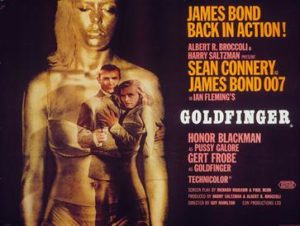 They say that the third time is the charm. If so, Goldfinger, the third film in the James Bond series, is exactly as good as it ought to be. Sean Connery is in top form as 007. Jill Masterson (Shirley Eaton) is imminently memorable for her gold-plated death. Gert Fröbe’s portrayal of Auric Goldfinger makes him one of the more iconic James Bond villains, and Harold Sakata’s Oddjob is equally iconic as Goldfinger’s silent and deadly hat-throwing servant. Honor Blackman is one of the better female costars of the series as the hilariously-named Pussy Galore, a pilot and judo expert who is capable and deadly in her own right.
They say that the third time is the charm. If so, Goldfinger, the third film in the James Bond series, is exactly as good as it ought to be. Sean Connery is in top form as 007. Jill Masterson (Shirley Eaton) is imminently memorable for her gold-plated death. Gert Fröbe’s portrayal of Auric Goldfinger makes him one of the more iconic James Bond villains, and Harold Sakata’s Oddjob is equally iconic as Goldfinger’s silent and deadly hat-throwing servant. Honor Blackman is one of the better female costars of the series as the hilariously-named Pussy Galore, a pilot and judo expert who is capable and deadly in her own right.
Goldfinger’s plan to use a nuclear “dirty bomb” to render the gold in the American depository at Fort Knox, Kentucky, worthless, thereby increasing the value of his own gold, is both absurd and ingenious. The scene with Bond about to be sliced in half by Goldfinger’s industrial laser is also absurd, and yet remains one of the most memorable and dramatic moments in the series. And Goldfinger’s retort to Bond when he asks if Goldfinger expects him to talk is one of my favorite lines in the series: “No, Mr. Bond, I expect you to die.”
This is the film that took James Bond from secret agent to incomparable international icon . . . but that’s not why I rank it at the top. The cause-and-effect is the other way around. This film had the impact it had because it is 007 at its best. It is fun, exciting, original, and smart, with just the right amount of silliness and humor mixed in. It is the masterpiece of the James Bond canon, which has been much imitated (both within the series and in parodies) but never surpassed.
Changes
This post will be updated soon after new James Bond films are released on home video. Each new film will be rated, reviewed, and added to the list, and details about those updates will be cataloged here.


